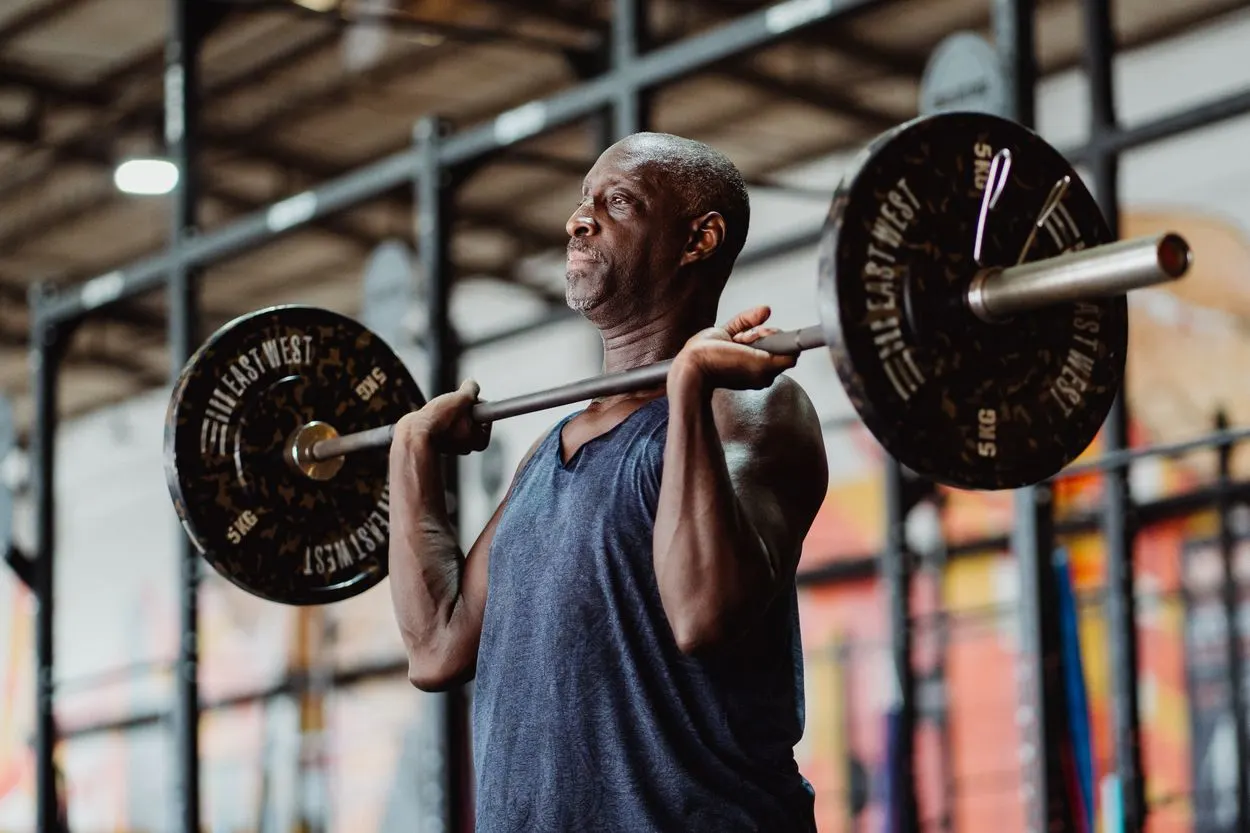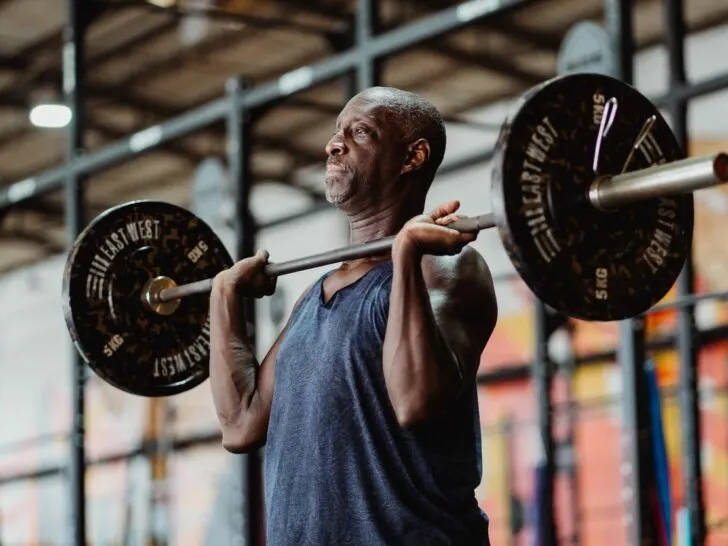This statistic shows that 28.79 million Americans own free weights (barbells) from 2011 to 2020. Weight lifting is one of the most popular exercises to stay in shape. Let me tell you that weight lifting exercises are well-known among athletes or gym enthusiasts. For someone who’s never indulged in any of the above-mentioned exercises, it’ll stress their shoulders while lifting weights overhead.
You might wonder what the difference is between military press and overhead press. Here’s a quick answer:
The common thing in both is that you lift the weight from your chest to overhead. According to the classical definition of military press, you must stand with your heels together when performing it. In the case of overhead press, you need to stand with your feet slightly apart. Interestingly, you won’t see anyone doing military press any longer. Both military press and overhead press are done the same way today.
You can perform military press only with a barbell. While overhead press can be done with either dumbbells or barbells.
If you’re interested in getting an in-depth comparison of both, this article might be helpful for you. So, stick around and keep on reading.
Benefits of Overhead Press
This type of weight lifting has numerous benefits.
- An improvement in shoulder and chest muscles
- The range of motion of the shoulder improves
What Does the Military Press Build?
- Build triceps
- Deltoid muscles
- Shoulder muscles
Overhead Vs. Military Press: Which one is easier?
You can watch this video for an in-depth tutorial on both lifts.
If you compare both exercises, you will find the overhead press an easier one. You can stand with open legs while doing it. On the other hand, when you are doing military press, less chest engagement is required and your standing position would be an “attention” one.
When you do a military press, all your muscles will not be activated. On the other hand, with the overhead press, all your muscles get activated. Military press being the strict one doesn’t benefit you the way overhead press does.
| Military Press | Overhead Press | |
| Body Parts Engaged | Neck Arms Shoulders | Knees Upper Chest Arms Traps Shoulders |
Military vs. Overhead Press

Let’s compare both;
| Overhead Press | Military Press |
| Weight lifting overhead | Weight lifting overhead |
| Stand with feet shoulder-width apart | Heels together |
| Parts you can move;Hips | Parts you can move Arms Shoulders |
| Body is stabilized | Body is unstabilized |
| In-front of head | Behind the head |
| Doesn’t cause any danger with the right technique. | Wrong technique may cause shoulder injury |
| Can do in two positions; standing or seated |
Muscles Engaged in Overhead Vs. Military Press
The muscle group engaged in OHP and military press are following;
| Overhead Press | Military Press |
| Anterior delts | Deltoids |
| Medial delts | Abdominals |
| Triceps | Triceps |
| Chest |
The impact they leave on your body is considerably different.
Interestingly, you can perform these lifts both in front of your head and as well as behind the head. Therefore, like many individuals, you may have concerns regarding the effects this kind of lift might have on your trunk.
Traditional research indicates that this exercise isn’t dangerous to your shoulders. Keep in mind that it was thought that these lifts would only affect shoulders.
The latest work shows those with a stable trunk wouldn’t face any injury. Still, the great practice would be increasing your range of motion. The normal or ideal ROM for rotation should be 90°.
Does Overhead Press Help Build Chest?

OHP doesn’t help build the chest. With this type of weight lifting, you won’t be targeting your lower chest and mid-chest. As discussed initially, the body parts this weight lifting targets include the shoulders and triceps.
If you want to build your chest and triceps, you should go for a bench press. Whereas, OHP builds your shoulders and triceps.
Does Overhead Or Military Press Hurt Your Shoulders?
If you follow the right techniques, none of these will affect your shoulders. The position of the bar plays a significant role in keeping you safe from muscular and bone injuries.
Position Of The Bar

Here’s where you should position the bar in both exercises;
- Beginning with a bar placed above your shoulders is the first step in the military press. Now, it matters where you should stop. You should lift the bar right at the top of your ribcage.
- Overhead presses are often performed incorrectly. To start with, you need to place a bar at the collarbone. And you should stop it where your legs or spine are.
Overall, both the liftings will not cause any problems if done properly. To avoid stressing your shoulders too much, you should never overdo any of these exercises. Also, these exercises are only suitable for those who’ve any sporting goals.
Conclusion
- Weight Lifting Popularity:
- Significant statistics reveal that millions of Americans own free weights (barbells). It emphasizes the popularity of weightlifting from 2011 to 2020.
- Military Press vs. Overhead Press:
- Both involve lifting weight from the chest to overhead raditionally. The military press requires heels together. Whereas the overhead press allows open legs. However, the distinction has diminished in contemporary practices.
- Equipment and Variety:
- The military press is limited to barbells. Whereas overhead press can be performed with either dumbbells or barbells. It provides more versatility.
- Benefits of Overhead Press:
- Enhances shoulder and chest muscles, improving shoulder range of motion.
- Comparison of Difficulty:
- Overhead press is generally considered easier. It allows a more open stance, engaging all muscles. Whereas the military press is stricter and may not activate all muscles.
- Muscles Engaged:
- Overhead press engages anterior and medial delts, triceps, and chest. Whereas military press involves deltoids, abdominals, and triceps.
- Safety Concerns:
- Proper technique is crucial to prevent shoulder injuries in both exercises. Put attention to bar positioning during lifts.
- Chest Building and Shoulder Safety:
- Overhead press primarily targets shoulders and triceps, not the chest. The bench press is recommended for chest development. Correct bar placement in both exercises ensures shoulder safety.
More Reads
- The Difference Between Seeing Someone, Dating Someone, and Having a Girlfriend/Boyfriend
- Hi-Fi vs Low-Fi Music (Detailed Contrast)
- FRIENDLY CUDDLING VS ROMANTIC CUDDLING (MEANING)
A web story that differentiated the two in a summarized manner can be found when you click here.

